Software Development Life Cycle Models and Feasibility Report
VerifiedAdded on 2020/11/13
|24
|5075
|934
Report
AI Summary
This report provides a comprehensive overview of Software Development Life Cycle (SDLC) models, including Waterfall, Spiral, V-Model, and RAD, explaining their principles, advantages, disadvantages, and when to apply each model. It also delves into the importance and components of a feasibility report, covering technical, operational, economic, legal, and schedule feasibility. The report further explains how risk is managed in the Spiral lifecycle model and discusses technical solutions for system development. The report aims to provide a clear understanding of the SDLC processes and their application in software development projects. The document is a solved assignment from a student to be published on Desklib, a platform providing AI-based study tools.
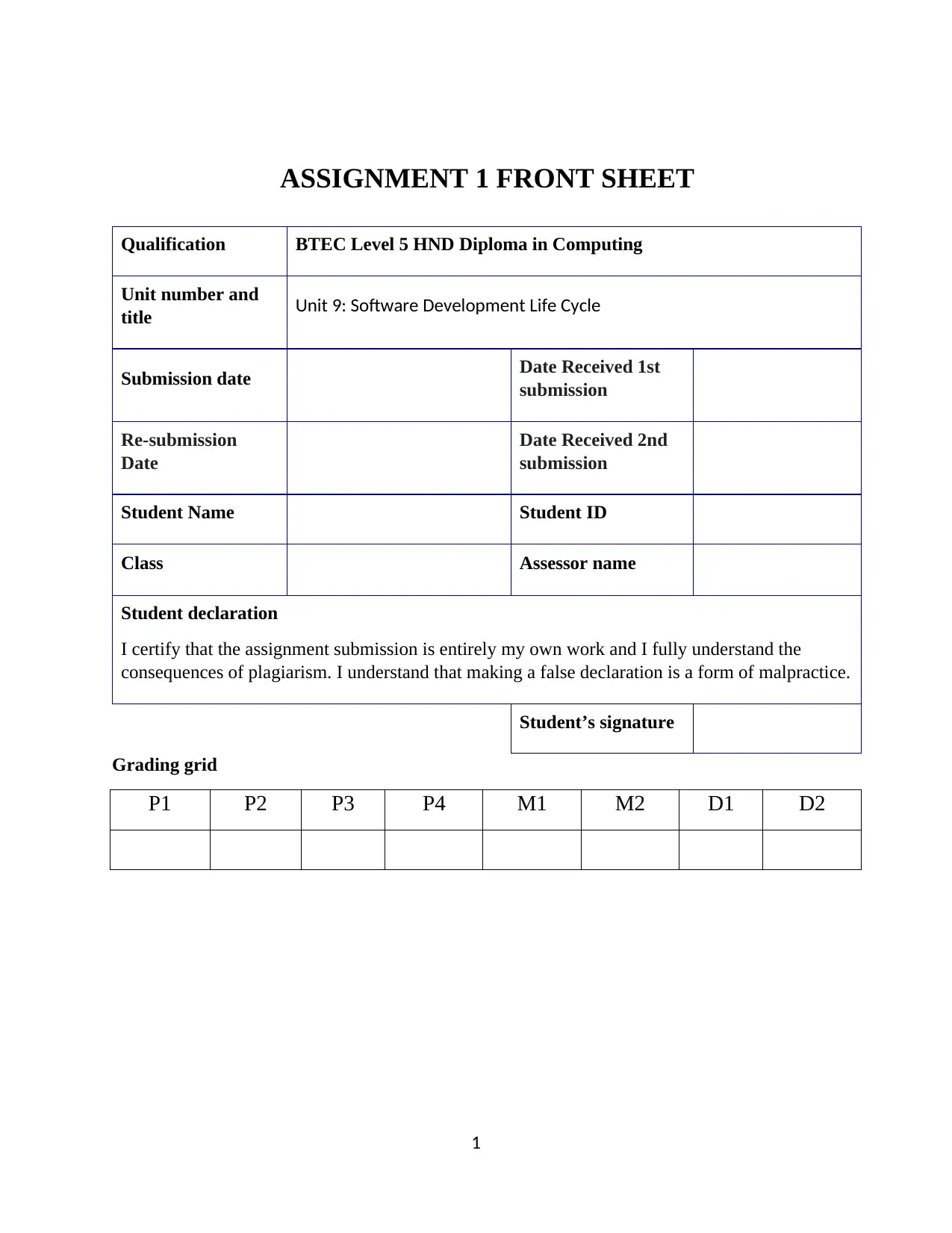
ASSIGNMENT 1 FRONT SHEET
Qualification BTEC Level 5 HND Diploma in Computing
Unit number and
title Unit 9: Software Development Life Cycle
Submission date Date Received 1st
submission
Re-submission
Date
Date Received 2nd
submission
Student Name Student ID
Class Assessor name
Student declaration
I certify that the assignment submission is entirely my own work and I fully understand the
consequences of plagiarism. I understand that making a false declaration is a form of malpractice.
Student’s signature
Grading grid
P1 P2 P3 P4 M1 M2 D1 D2
1
Qualification BTEC Level 5 HND Diploma in Computing
Unit number and
title Unit 9: Software Development Life Cycle
Submission date Date Received 1st
submission
Re-submission
Date
Date Received 2nd
submission
Student Name Student ID
Class Assessor name
Student declaration
I certify that the assignment submission is entirely my own work and I fully understand the
consequences of plagiarism. I understand that making a false declaration is a form of malpractice.
Student’s signature
Grading grid
P1 P2 P3 P4 M1 M2 D1 D2
1
Paraphrase This Document
Need a fresh take? Get an instant paraphrase of this document with our AI Paraphraser
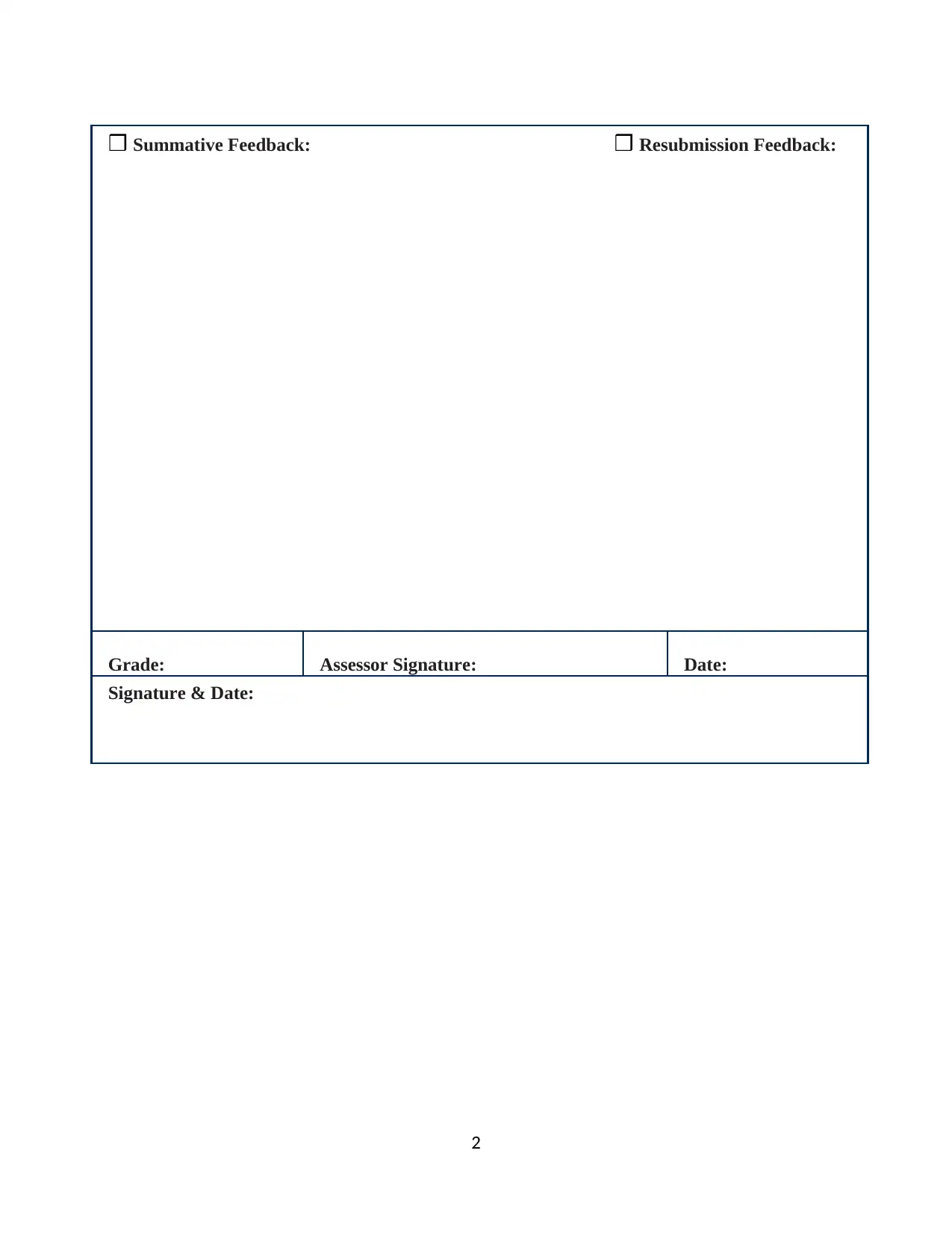
❒ Summative Feedback: ❒ Resubmission Feedback:
Grade: Assessor Signature: Date:
Signature & Date:
2
Grade: Assessor Signature: Date:
Signature & Date:
2

3
⊘ This is a preview!⊘
Do you want full access?
Subscribe today to unlock all pages.

Trusted by 1+ million students worldwide
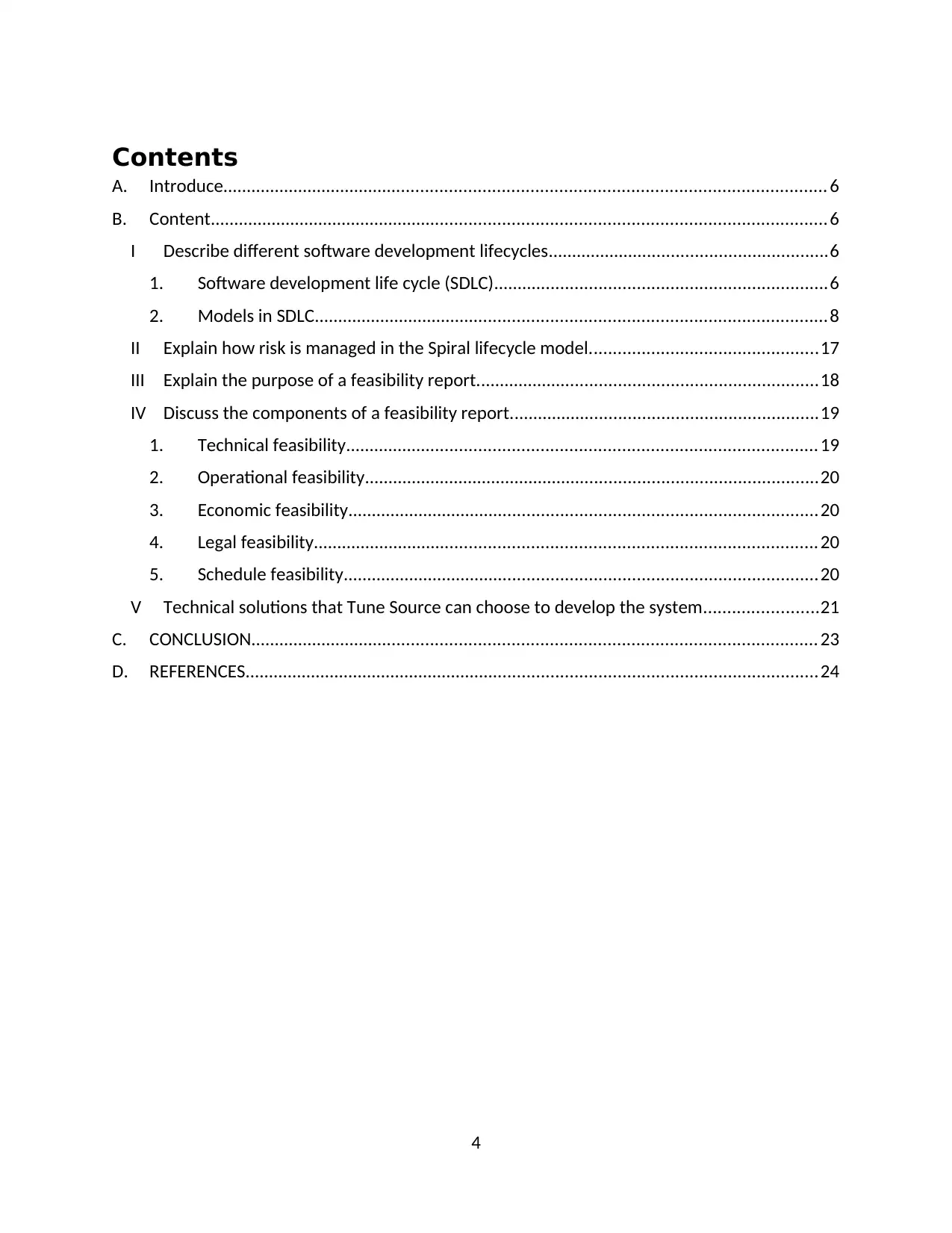
Contents
A. Introduce............................................................................................................................... 6
B. Content.................................................................................................................................. 6
I Describe different software development lifecycles...........................................................6
1. Software development life cycle (SDLC)......................................................................6
2. Models in SDLC............................................................................................................8
II Explain how risk is managed in the Spiral lifecycle model................................................17
III Explain the purpose of a feasibility report........................................................................18
IV Discuss the components of a feasibility report.................................................................19
1. Technical feasibility................................................................................................... 19
2. Operational feasibility................................................................................................20
3. Economic feasibility...................................................................................................20
4. Legal feasibility.......................................................................................................... 20
5. Schedule feasibility....................................................................................................20
V Technical solutions that Tune Source can choose to develop the system........................21
C. CONCLUSION....................................................................................................................... 23
D. REFERENCES.........................................................................................................................24
4
A. Introduce............................................................................................................................... 6
B. Content.................................................................................................................................. 6
I Describe different software development lifecycles...........................................................6
1. Software development life cycle (SDLC)......................................................................6
2. Models in SDLC............................................................................................................8
II Explain how risk is managed in the Spiral lifecycle model................................................17
III Explain the purpose of a feasibility report........................................................................18
IV Discuss the components of a feasibility report.................................................................19
1. Technical feasibility................................................................................................... 19
2. Operational feasibility................................................................................................20
3. Economic feasibility...................................................................................................20
4. Legal feasibility.......................................................................................................... 20
5. Schedule feasibility....................................................................................................20
V Technical solutions that Tune Source can choose to develop the system........................21
C. CONCLUSION....................................................................................................................... 23
D. REFERENCES.........................................................................................................................24
4
Paraphrase This Document
Need a fresh take? Get an instant paraphrase of this document with our AI Paraphraser
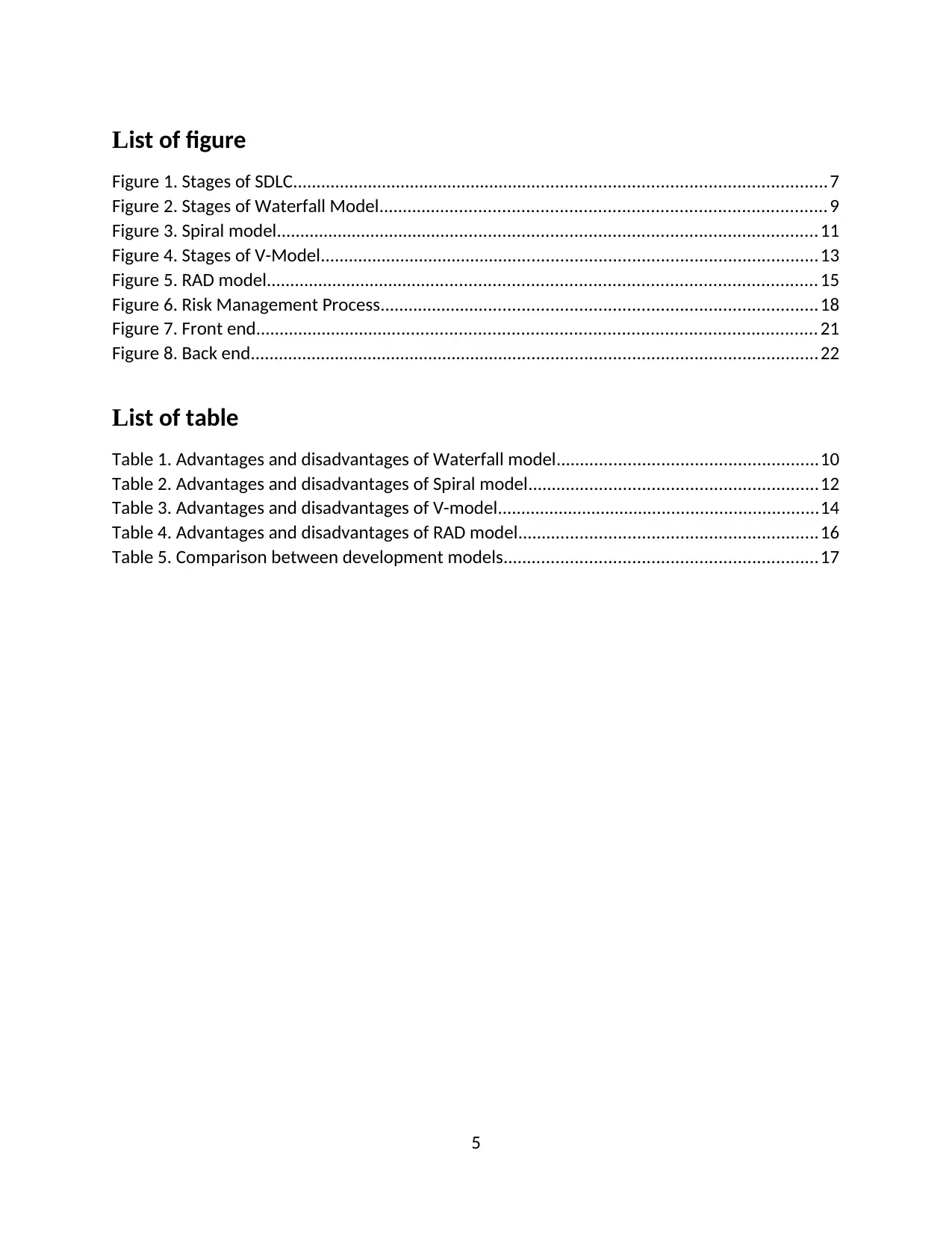
List of figure
Figure 1. Stages of SDLC.................................................................................................................7
Figure 2. Stages of Waterfall Model..............................................................................................9
Figure 3. Spiral model.................................................................................................................. 11
Figure 4. Stages of V-Model.........................................................................................................13
Figure 5. RAD model.................................................................................................................... 15
Figure 6. Risk Management Process............................................................................................18
Figure 7. Front end...................................................................................................................... 21
Figure 8. Back end........................................................................................................................22
List of table
Table 1. Advantages and disadvantages of Waterfall model.......................................................10
Table 2. Advantages and disadvantages of Spiral model.............................................................12
Table 3. Advantages and disadvantages of V-model....................................................................14
Table 4. Advantages and disadvantages of RAD model...............................................................16
Table 5. Comparison between development models..................................................................17
5
Figure 1. Stages of SDLC.................................................................................................................7
Figure 2. Stages of Waterfall Model..............................................................................................9
Figure 3. Spiral model.................................................................................................................. 11
Figure 4. Stages of V-Model.........................................................................................................13
Figure 5. RAD model.................................................................................................................... 15
Figure 6. Risk Management Process............................................................................................18
Figure 7. Front end...................................................................................................................... 21
Figure 8. Back end........................................................................................................................22
List of table
Table 1. Advantages and disadvantages of Waterfall model.......................................................10
Table 2. Advantages and disadvantages of Spiral model.............................................................12
Table 3. Advantages and disadvantages of V-model....................................................................14
Table 4. Advantages and disadvantages of RAD model...............................................................16
Table 5. Comparison between development models..................................................................17
5
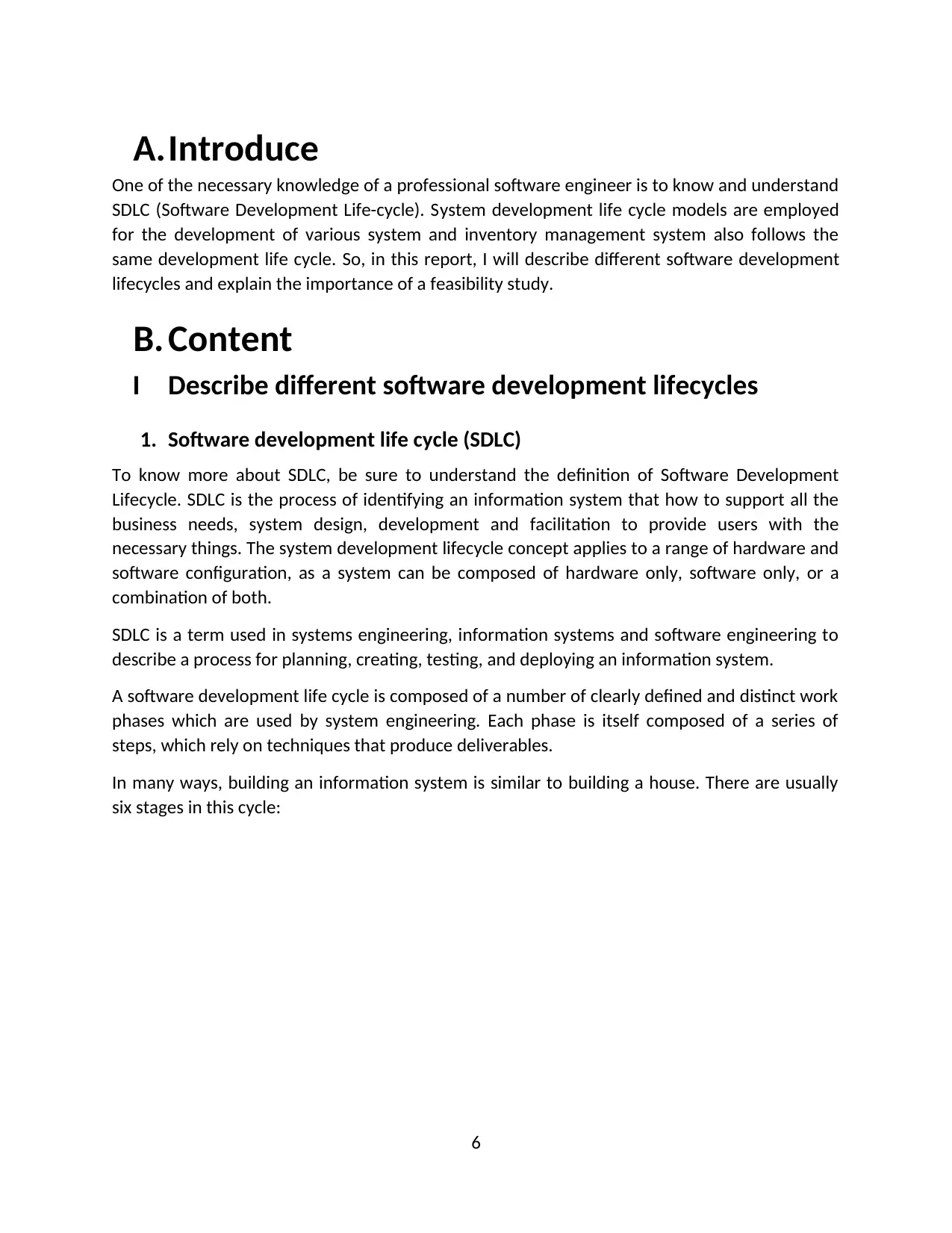
A.Introduce
One of the necessary knowledge of a professional software engineer is to know and understand
SDLC (Software Development Life-cycle). System development life cycle models are employed
for the development of various system and inventory management system also follows the
same development life cycle. So, in this report, I will describe different software development
lifecycles and explain the importance of a feasibility study.
B. Content
I Describe different software development lifecycles
1. Software development life cycle (SDLC)
To know more about SDLC, be sure to understand the definition of Software Development
Lifecycle. SDLC is the process of identifying an information system that how to support all the
business needs, system design, development and facilitation to provide users with the
necessary things. The system development lifecycle concept applies to a range of hardware and
software configuration, as a system can be composed of hardware only, software only, or a
combination of both.
SDLC is a term used in systems engineering, information systems and software engineering to
describe a process for planning, creating, testing, and deploying an information system.
A software development life cycle is composed of a number of clearly defined and distinct work
phases which are used by system engineering. Each phase is itself composed of a series of
steps, which rely on techniques that produce deliverables.
In many ways, building an information system is similar to building a house. There are usually
six stages in this cycle:
6
One of the necessary knowledge of a professional software engineer is to know and understand
SDLC (Software Development Life-cycle). System development life cycle models are employed
for the development of various system and inventory management system also follows the
same development life cycle. So, in this report, I will describe different software development
lifecycles and explain the importance of a feasibility study.
B. Content
I Describe different software development lifecycles
1. Software development life cycle (SDLC)
To know more about SDLC, be sure to understand the definition of Software Development
Lifecycle. SDLC is the process of identifying an information system that how to support all the
business needs, system design, development and facilitation to provide users with the
necessary things. The system development lifecycle concept applies to a range of hardware and
software configuration, as a system can be composed of hardware only, software only, or a
combination of both.
SDLC is a term used in systems engineering, information systems and software engineering to
describe a process for planning, creating, testing, and deploying an information system.
A software development life cycle is composed of a number of clearly defined and distinct work
phases which are used by system engineering. Each phase is itself composed of a series of
steps, which rely on techniques that produce deliverables.
In many ways, building an information system is similar to building a house. There are usually
six stages in this cycle:
6
⊘ This is a preview!⊘
Do you want full access?
Subscribe today to unlock all pages.

Trusted by 1+ million students worldwide
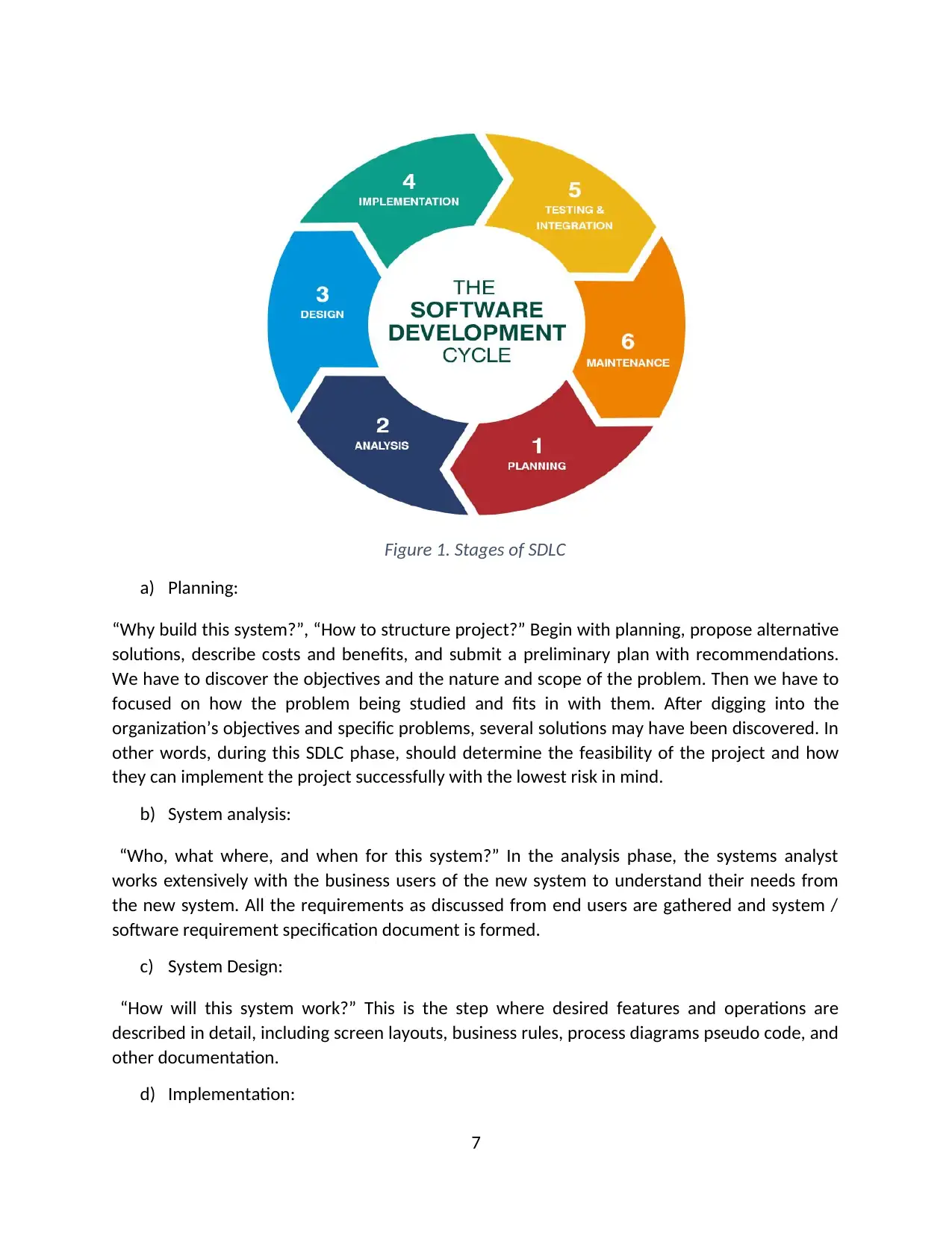
Figure 1. Stages of SDLC
a) Planning:
“Why build this system?”, “How to structure project?” Begin with planning, propose alternative
solutions, describe costs and benefits, and submit a preliminary plan with recommendations.
We have to discover the objectives and the nature and scope of the problem. Then we have to
focused on how the problem being studied and fits in with them. After digging into the
organization’s objectives and specific problems, several solutions may have been discovered. In
other words, during this SDLC phase, should determine the feasibility of the project and how
they can implement the project successfully with the lowest risk in mind.
b) System analysis:
“Who, what where, and when for this system?” In the analysis phase, the systems analyst
works extensively with the business users of the new system to understand their needs from
the new system. All the requirements as discussed from end users are gathered and system /
software requirement specification document is formed.
c) System Design:
“How will this system work?” This is the step where desired features and operations are
described in detail, including screen layouts, business rules, process diagrams pseudo code, and
other documentation.
d) Implementation:
7
a) Planning:
“Why build this system?”, “How to structure project?” Begin with planning, propose alternative
solutions, describe costs and benefits, and submit a preliminary plan with recommendations.
We have to discover the objectives and the nature and scope of the problem. Then we have to
focused on how the problem being studied and fits in with them. After digging into the
organization’s objectives and specific problems, several solutions may have been discovered. In
other words, during this SDLC phase, should determine the feasibility of the project and how
they can implement the project successfully with the lowest risk in mind.
b) System analysis:
“Who, what where, and when for this system?” In the analysis phase, the systems analyst
works extensively with the business users of the new system to understand their needs from
the new system. All the requirements as discussed from end users are gathered and system /
software requirement specification document is formed.
c) System Design:
“How will this system work?” This is the step where desired features and operations are
described in detail, including screen layouts, business rules, process diagrams pseudo code, and
other documentation.
d) Implementation:
7
Paraphrase This Document
Need a fresh take? Get an instant paraphrase of this document with our AI Paraphraser
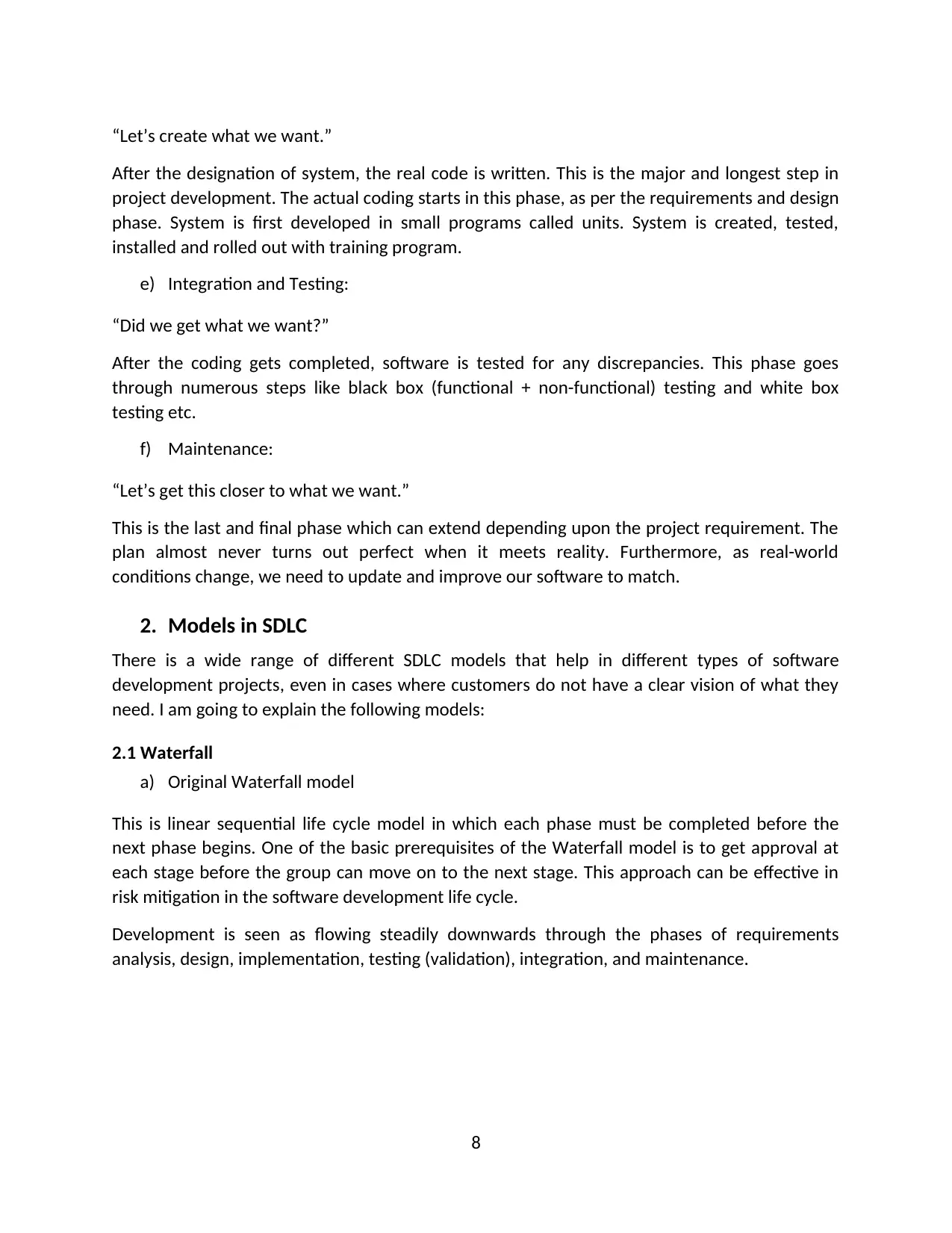
“Let’s create what we want.”
After the designation of system, the real code is written. This is the major and longest step in
project development. The actual coding starts in this phase, as per the requirements and design
phase. System is first developed in small programs called units. System is created, tested,
installed and rolled out with training program.
e) Integration and Testing:
“Did we get what we want?”
After the coding gets completed, software is tested for any discrepancies. This phase goes
through numerous steps like black box (functional + non-functional) testing and white box
testing etc.
f) Maintenance:
“Let’s get this closer to what we want.”
This is the last and final phase which can extend depending upon the project requirement. The
plan almost never turns out perfect when it meets reality. Furthermore, as real-world
conditions change, we need to update and improve our software to match.
2. Models in SDLC
There is a wide range of different SDLC models that help in different types of software
development projects, even in cases where customers do not have a clear vision of what they
need. I am going to explain the following models:
2.1 Waterfall
a) Original Waterfall model
This is linear sequential life cycle model in which each phase must be completed before the
next phase begins. One of the basic prerequisites of the Waterfall model is to get approval at
each stage before the group can move on to the next stage. This approach can be effective in
risk mitigation in the software development life cycle.
Development is seen as flowing steadily downwards through the phases of requirements
analysis, design, implementation, testing (validation), integration, and maintenance.
8
After the designation of system, the real code is written. This is the major and longest step in
project development. The actual coding starts in this phase, as per the requirements and design
phase. System is first developed in small programs called units. System is created, tested,
installed and rolled out with training program.
e) Integration and Testing:
“Did we get what we want?”
After the coding gets completed, software is tested for any discrepancies. This phase goes
through numerous steps like black box (functional + non-functional) testing and white box
testing etc.
f) Maintenance:
“Let’s get this closer to what we want.”
This is the last and final phase which can extend depending upon the project requirement. The
plan almost never turns out perfect when it meets reality. Furthermore, as real-world
conditions change, we need to update and improve our software to match.
2. Models in SDLC
There is a wide range of different SDLC models that help in different types of software
development projects, even in cases where customers do not have a clear vision of what they
need. I am going to explain the following models:
2.1 Waterfall
a) Original Waterfall model
This is linear sequential life cycle model in which each phase must be completed before the
next phase begins. One of the basic prerequisites of the Waterfall model is to get approval at
each stage before the group can move on to the next stage. This approach can be effective in
risk mitigation in the software development life cycle.
Development is seen as flowing steadily downwards through the phases of requirements
analysis, design, implementation, testing (validation), integration, and maintenance.
8

Figure 2. Stages of Waterfall Model
b) Basic principles of Waterfall model
The fundamental principle of waterfall project management is simplicity.
Project is divided into sequential phases, with some overlap and splash back acceptable
between phases; emphasis is on planning, time schedules, target dates, budgets and
implementation of an entire system at one time.
Requirements and delivery products, with detailed specifications, are required from the outset.
All team members need to know their roles and the roles of others in order to fulfill their part
of the process.
Documentation should be thorough and sent to everyone involved in the project.
c) When to use Waterfall model
- The requirements and scope are well understood.
- Ample resources with required expertise are available freely.
- The client has high confidence in the organization.
- The project is short.
- It is good to use this model when the technology is well understood.
d) Advantages and disadvantages of Waterfall model
9
b) Basic principles of Waterfall model
The fundamental principle of waterfall project management is simplicity.
Project is divided into sequential phases, with some overlap and splash back acceptable
between phases; emphasis is on planning, time schedules, target dates, budgets and
implementation of an entire system at one time.
Requirements and delivery products, with detailed specifications, are required from the outset.
All team members need to know their roles and the roles of others in order to fulfill their part
of the process.
Documentation should be thorough and sent to everyone involved in the project.
c) When to use Waterfall model
- The requirements and scope are well understood.
- Ample resources with required expertise are available freely.
- The client has high confidence in the organization.
- The project is short.
- It is good to use this model when the technology is well understood.
d) Advantages and disadvantages of Waterfall model
9
⊘ This is a preview!⊘
Do you want full access?
Subscribe today to unlock all pages.

Trusted by 1+ million students worldwide
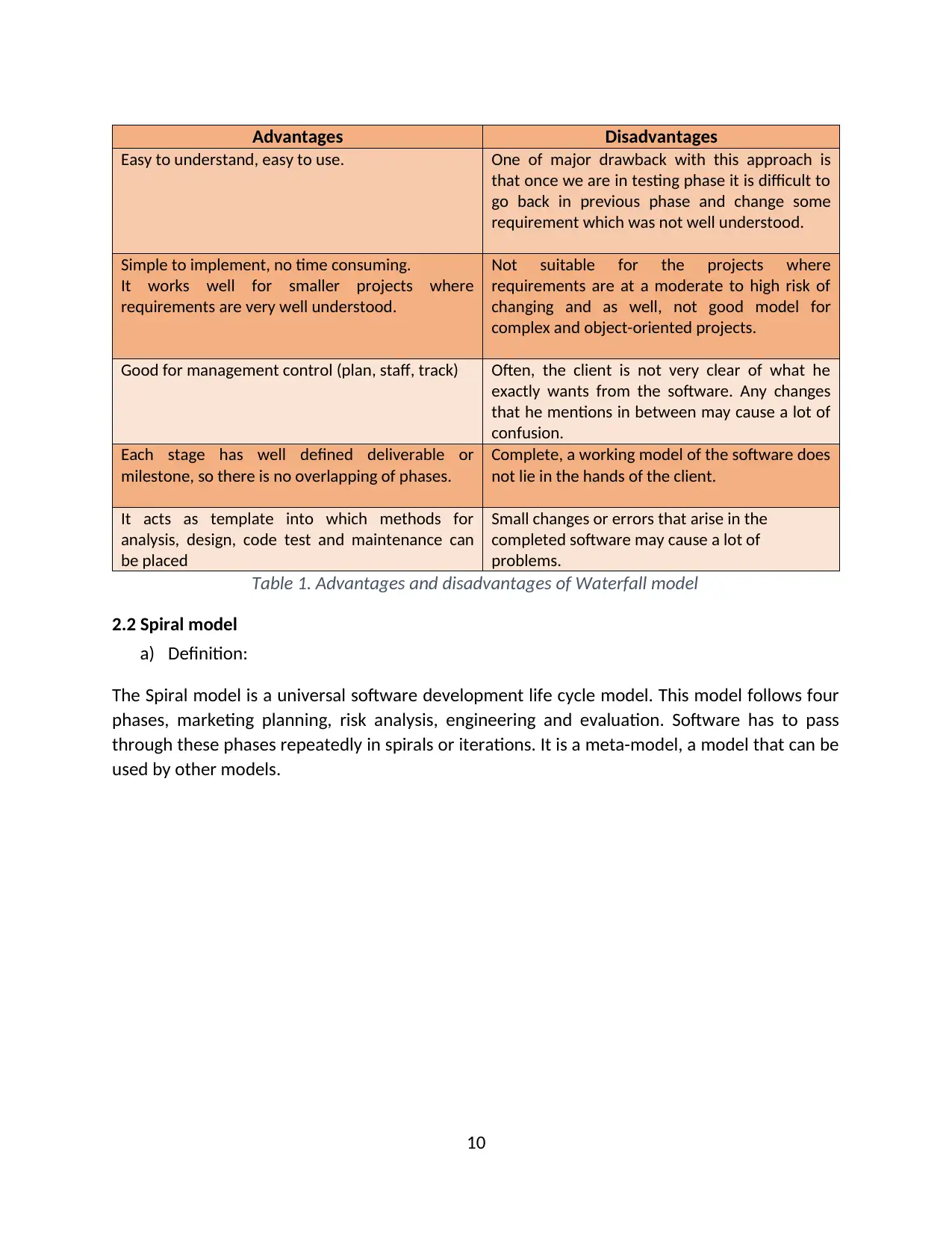
Advantages Disadvantages
Easy to understand, easy to use. One of major drawback with this approach is
that once we are in testing phase it is difficult to
go back in previous phase and change some
requirement which was not well understood.
Simple to implement, no time consuming.
It works well for smaller projects where
requirements are very well understood.
Not suitable for the projects where
requirements are at a moderate to high risk of
changing and as well, not good model for
complex and object-oriented projects.
Good for management control (plan, staff, track) Often, the client is not very clear of what he
exactly wants from the software. Any changes
that he mentions in between may cause a lot of
confusion.
Each stage has well defined deliverable or
milestone, so there is no overlapping of phases.
Complete, a working model of the software does
not lie in the hands of the client.
It acts as template into which methods for
analysis, design, code test and maintenance can
be placed
Small changes or errors that arise in the
completed software may cause a lot of
problems.
Table 1. Advantages and disadvantages of Waterfall model
2.2 Spiral model
a) Definition:
The Spiral model is a universal software development life cycle model. This model follows four
phases, marketing planning, risk analysis, engineering and evaluation. Software has to pass
through these phases repeatedly in spirals or iterations. It is a meta-model, a model that can be
used by other models.
10
Easy to understand, easy to use. One of major drawback with this approach is
that once we are in testing phase it is difficult to
go back in previous phase and change some
requirement which was not well understood.
Simple to implement, no time consuming.
It works well for smaller projects where
requirements are very well understood.
Not suitable for the projects where
requirements are at a moderate to high risk of
changing and as well, not good model for
complex and object-oriented projects.
Good for management control (plan, staff, track) Often, the client is not very clear of what he
exactly wants from the software. Any changes
that he mentions in between may cause a lot of
confusion.
Each stage has well defined deliverable or
milestone, so there is no overlapping of phases.
Complete, a working model of the software does
not lie in the hands of the client.
It acts as template into which methods for
analysis, design, code test and maintenance can
be placed
Small changes or errors that arise in the
completed software may cause a lot of
problems.
Table 1. Advantages and disadvantages of Waterfall model
2.2 Spiral model
a) Definition:
The Spiral model is a universal software development life cycle model. This model follows four
phases, marketing planning, risk analysis, engineering and evaluation. Software has to pass
through these phases repeatedly in spirals or iterations. It is a meta-model, a model that can be
used by other models.
10
Paraphrase This Document
Need a fresh take? Get an instant paraphrase of this document with our AI Paraphraser
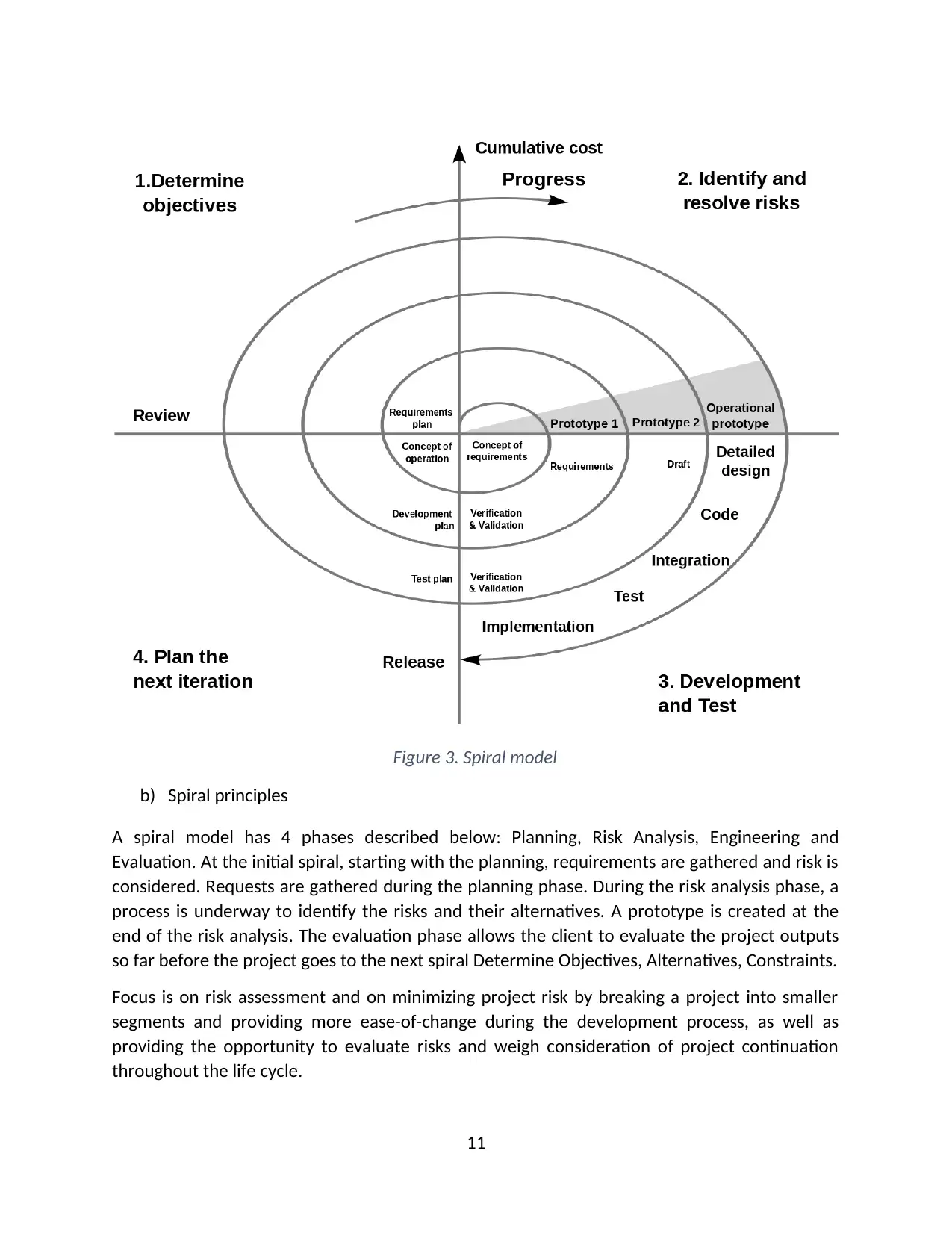
Figure 3. Spiral model
b) Spiral principles
A spiral model has 4 phases described below: Planning, Risk Analysis, Engineering and
Evaluation. At the initial spiral, starting with the planning, requirements are gathered and risk is
considered. Requests are gathered during the planning phase. During the risk analysis phase, a
process is underway to identify the risks and their alternatives. A prototype is created at the
end of the risk analysis. The evaluation phase allows the client to evaluate the project outputs
so far before the project goes to the next spiral Determine Objectives, Alternatives, Constraints.
Focus is on risk assessment and on minimizing project risk by breaking a project into smaller
segments and providing more ease-of-change during the development process, as well as
providing the opportunity to evaluate risks and weigh consideration of project continuation
throughout the life cycle.
11
b) Spiral principles
A spiral model has 4 phases described below: Planning, Risk Analysis, Engineering and
Evaluation. At the initial spiral, starting with the planning, requirements are gathered and risk is
considered. Requests are gathered during the planning phase. During the risk analysis phase, a
process is underway to identify the risks and their alternatives. A prototype is created at the
end of the risk analysis. The evaluation phase allows the client to evaluate the project outputs
so far before the project goes to the next spiral Determine Objectives, Alternatives, Constraints.
Focus is on risk assessment and on minimizing project risk by breaking a project into smaller
segments and providing more ease-of-change during the development process, as well as
providing the opportunity to evaluate risks and weigh consideration of project continuation
throughout the life cycle.
11
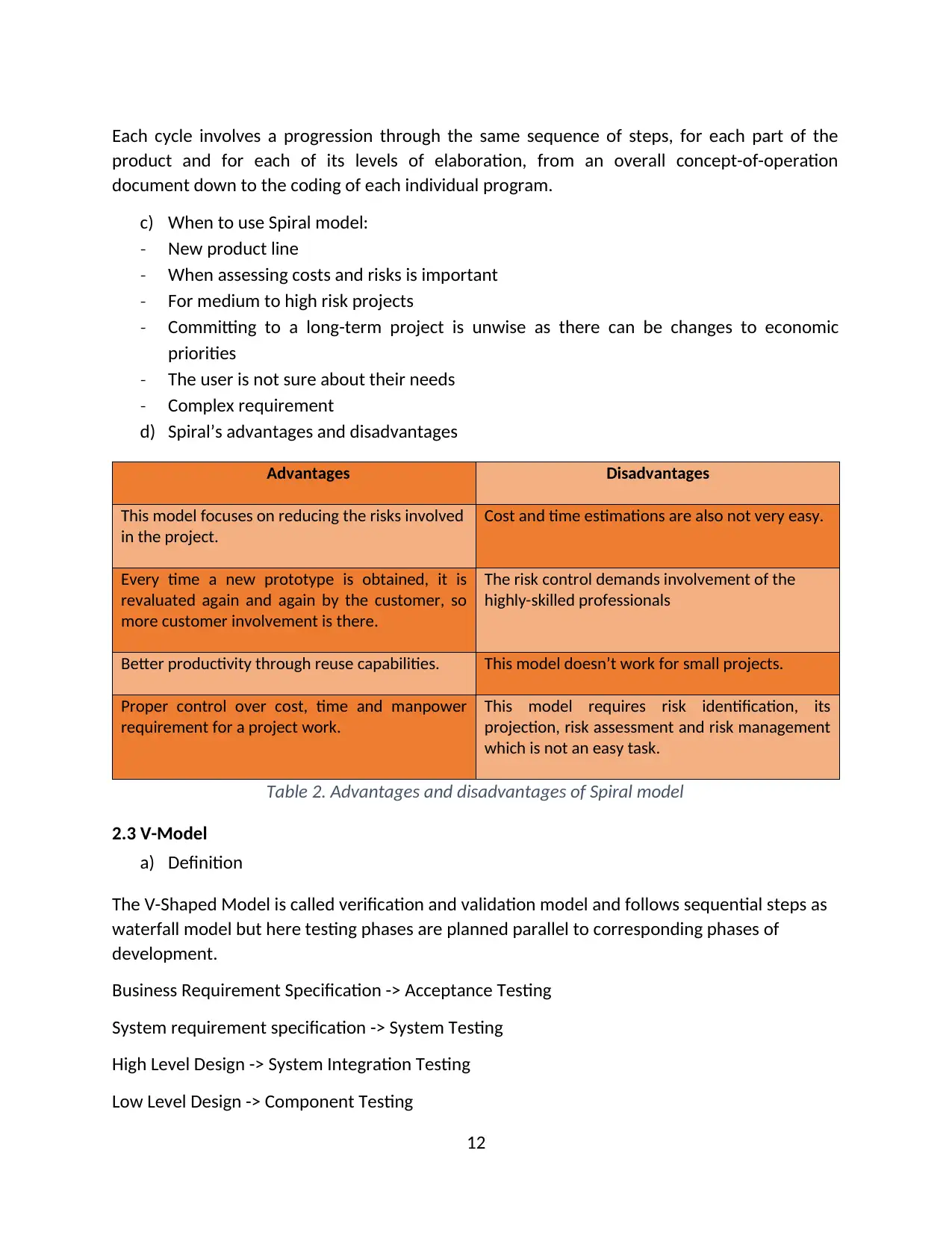
Each cycle involves a progression through the same sequence of steps, for each part of the
product and for each of its levels of elaboration, from an overall concept-of-operation
document down to the coding of each individual program.
c) When to use Spiral model:
- New product line
- When assessing costs and risks is important
- For medium to high risk projects
- Committing to a long-term project is unwise as there can be changes to economic
priorities
- The user is not sure about their needs
- Complex requirement
d) Spiral’s advantages and disadvantages
Advantages Disadvantages
This model focuses on reducing the risks involved
in the project.
Cost and time estimations are also not very easy.
Every time a new prototype is obtained, it is
revaluated again and again by the customer, so
more customer involvement is there.
The risk control demands involvement of the
highly-skilled professionals
Better productivity through reuse capabilities. This model doesn’t work for small projects.
Proper control over cost, time and manpower
requirement for a project work.
This model requires risk identification, its
projection, risk assessment and risk management
which is not an easy task.
Table 2. Advantages and disadvantages of Spiral model
2.3 V-Model
a) Definition
The V-Shaped Model is called verification and validation model and follows sequential steps as
waterfall model but here testing phases are planned parallel to corresponding phases of
development.
Business Requirement Specification -> Acceptance Testing
System requirement specification -> System Testing
High Level Design -> System Integration Testing
Low Level Design -> Component Testing
12
product and for each of its levels of elaboration, from an overall concept-of-operation
document down to the coding of each individual program.
c) When to use Spiral model:
- New product line
- When assessing costs and risks is important
- For medium to high risk projects
- Committing to a long-term project is unwise as there can be changes to economic
priorities
- The user is not sure about their needs
- Complex requirement
d) Spiral’s advantages and disadvantages
Advantages Disadvantages
This model focuses on reducing the risks involved
in the project.
Cost and time estimations are also not very easy.
Every time a new prototype is obtained, it is
revaluated again and again by the customer, so
more customer involvement is there.
The risk control demands involvement of the
highly-skilled professionals
Better productivity through reuse capabilities. This model doesn’t work for small projects.
Proper control over cost, time and manpower
requirement for a project work.
This model requires risk identification, its
projection, risk assessment and risk management
which is not an easy task.
Table 2. Advantages and disadvantages of Spiral model
2.3 V-Model
a) Definition
The V-Shaped Model is called verification and validation model and follows sequential steps as
waterfall model but here testing phases are planned parallel to corresponding phases of
development.
Business Requirement Specification -> Acceptance Testing
System requirement specification -> System Testing
High Level Design -> System Integration Testing
Low Level Design -> Component Testing
12
⊘ This is a preview!⊘
Do you want full access?
Subscribe today to unlock all pages.

Trusted by 1+ million students worldwide
1 out of 24
Related Documents
Your All-in-One AI-Powered Toolkit for Academic Success.
+13062052269
info@desklib.com
Available 24*7 on WhatsApp / Email
![[object Object]](/_next/static/media/star-bottom.7253800d.svg)
Unlock your academic potential
Copyright © 2020–2025 A2Z Services. All Rights Reserved. Developed and managed by ZUCOL.





